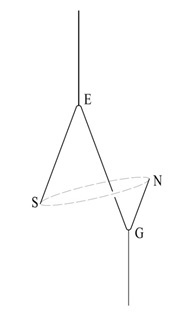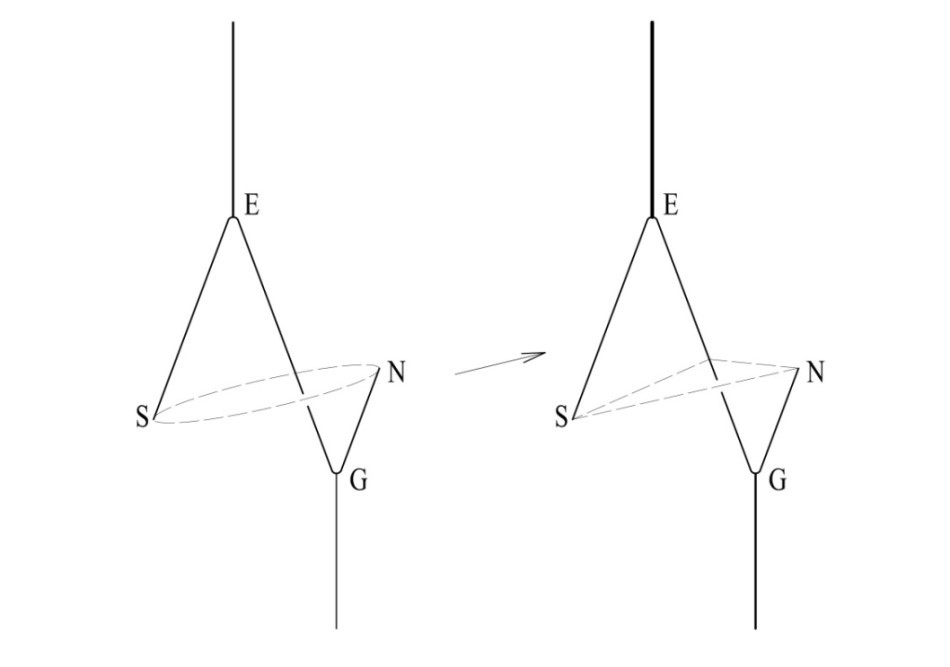In this note, we are going to explain what the evolution of dark energy from the kinematical side is.
According to Model 31, dark energy (ether) is an elementary, eternally existing form of matter that fills the Universe. Dark energy particles occur in the form of one-dimensional magnetic dipoles of less than 10-15 m in length and moving at a speed greater than 3 x 108 m/s. Dark energy particles have always been, are, and will be in motion. They move and collide with each other in a perfect vacuum, therefore their collisions are perfectly elastic. The perfectly elastic collisions of dark energy particles are their inherent, inalienable feature.
Since dark energy particles are dipoles, they can form lines and more complex two-dimensional linear elements, that is energy quanta.

quantum of energy
Quanta perform progressive motion and oscillatory motion. The driving force of the both motions is dark energy. The progressive motion is made at a constant speed of 299792458 m/s, while the oscillatory motion is variable and ranges within
0 < x < 1020 Hz. This means that energy quanta have constant energy (constant speed) and variable power (variable frequency of free vibrations). Energy quanta collide with each other and their collisions are perfectly elastic. The perfectly elastic collisions of energy quanta are not their inherent, inalienable feature. This is how dark energy gives the collisions their nature.
Energy quanta transform into three-dimensional electrons and positrons.

quantum of energy electron or positron
The idea of this transformation is to stabilize the oscillatory motion of electrons and positrons and to destabilize the kinetic energy of these particles. After the above mentioned transformation, the frequency of free vibrations of electrons and positrons stabilizes at the level of 1020 Hz, while the speed of motion is no longer constant and ranges within 0 < x < 299792458m/s. This means that electrons and positrons have constant power (constant frequency of free vibrations) and variable energy (variable speed). The driving force of the oscillatory motion of electrons and positrons are dark energy particles. A result of this motion is electric, magnetic, and gravitational field lines produced by electrons and positrons. The progressive motion is triggered by energy quanta. Electrons and positrons can collide with each other but this is already not their inherent feature. This phenomenon is even undesired, leading to their destruction (the phenomenon of annihilation). Therefore, all positrons are immobilized (frozen) in protons, while only electrons can appear in a free state.
A possible zero velocity of an electron and positron means that these particles of matter can connect with each other, which gives rise to the creation of proton that is made from electrons and positrons.
In a proton, and thus in all atomic nuclei existing in the Universe, electrons and positrons still vibrate with different frequencies. This motion is invisible outside. Protons perform only one kind of movement, that is progressive motion. During this motion, they collide with each other. The progressive motion of protons (atomic nuclei) is triggered by energy quanta. During this motion, they collide with each other. The collisions of atomic nuclei are not perfectly elastic. Between collisions, atomic nuclei can reach the speed from several thousand to almost 300000 km/s. This speed is too high for greater than nuclei forms of matter (atoms) to come into being.
Atoms are only formed when atomic nuclei are supplied with speed of movement retarders, that is electrons arranged at different distances from the protons. Then, atoms are subject to such a great resistance to motion that they slow down to a speed of several hundred kilometers per second. The collisions of atoms at such speeds result in the oscillatory motion of electrons building an atom. Vibrating electrons produce quanta of energy from dark energy particles. Collisions of atoms are not perfectly elastic. As it is apparent from the above, atoms made of modified quanta (electrons and positrons), just like quanta of energy, perform two kinds of movement, progressive motion and oscillatory motion.
With atoms moving at a speed of the order of several hundred kilometers per second, it becomes possible for atoms of a particular element to form solids, liquids and gases. Atoms in gases move in a random motion, in liquids the motion is partially random and partially ordered, while in solids this motion is completely ordered. The complete ordering is that the atoms of solids move and collide along the same strictly defined segments which constitute the edges of various polyhedra in a solid. This is how the crystal structure of solids originates. Although atoms in liquids, gases, and solids move at a speed of several hundred kilometers per second, these bodies as a whole have zero speed, have zero kinetic energy.
The above can be described in brief.
- Dark energy —- constant kinetic energy (velocity), constant frequency of collisions, lack of frequency of free vibrations.
- Quanta of energy —- constant kinetic energy (velocity), variable frequency of collisions, variable frequency of free vibrations (variable power).
- Electrons and positrons —- variable kinetic energy (velocity), lack of frequency of collisions, constant frequency of free vibrations (constant power).
- Protons (atomic nuclei) —- variable kinetic energy (velocity), variable frequency of collisions, lack of frequency of free vibrations.
- Atoms —- variable kinetic energy (velocity), variable frequency of collisions, variable frequency of free vibrations (electrons vibrate).
- Solids, liquids and gases (macrobodies) —- lack of kinetic energy (velocity), lack of frequency of collisions, lack of frequency of free vibrations.
If we compare points 1 and 6, we will note that the kinematical evolution of dark energy was about finding a way of transition from constantly moving particles of dark energy to being immobile solids.
As it is seen, this task was performed excellently.
Once again, this note shows how much Model 31 is different from the modern physics. Model 31 allows to present step by step the kinematical evolution of dark energy (ether), while physicists are not even able to establish a position regarding the existence of dark energy. These differences result from the lack of knowledge on the presence of subatomic and subquantum level of the organization of matter.

